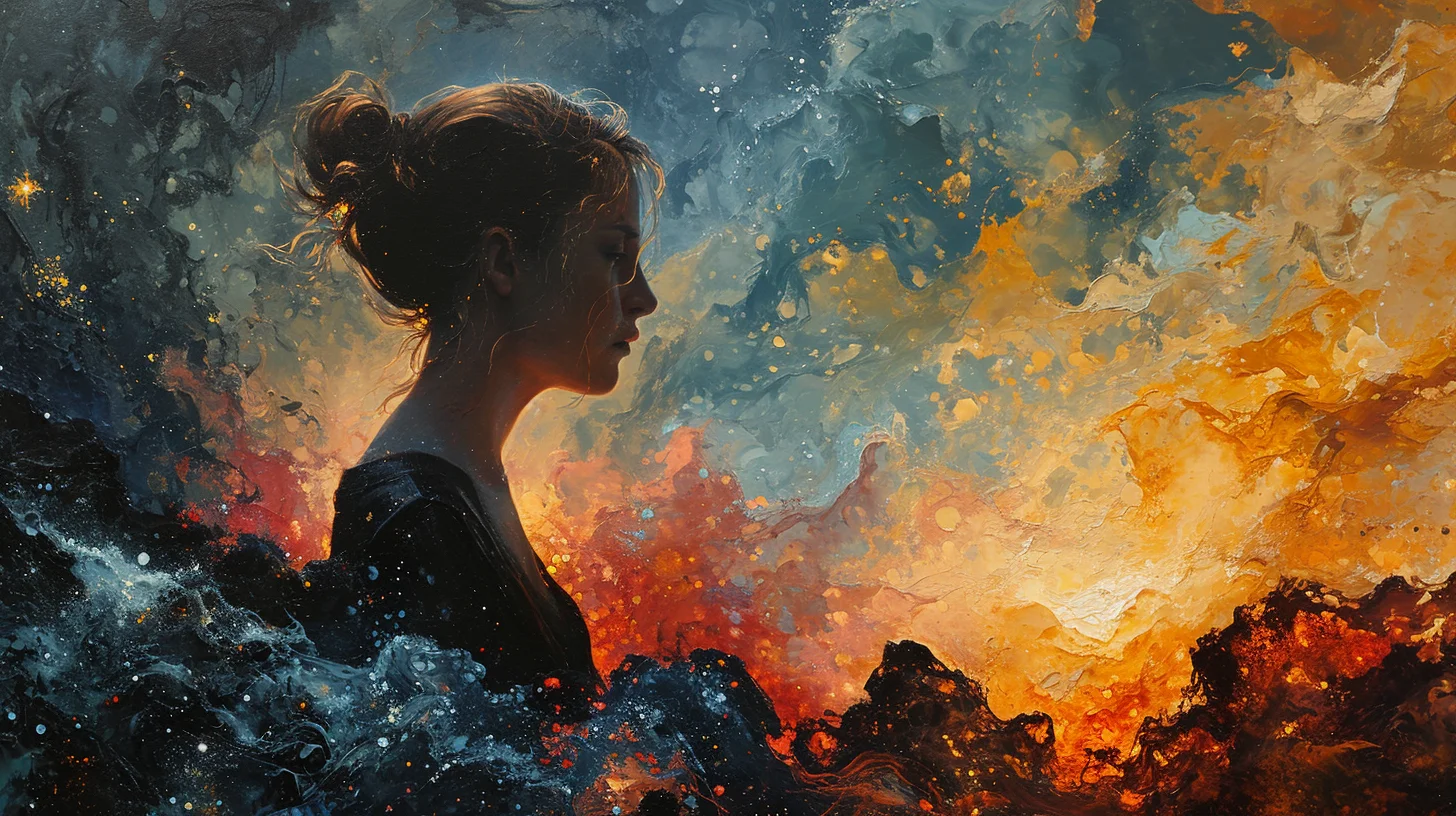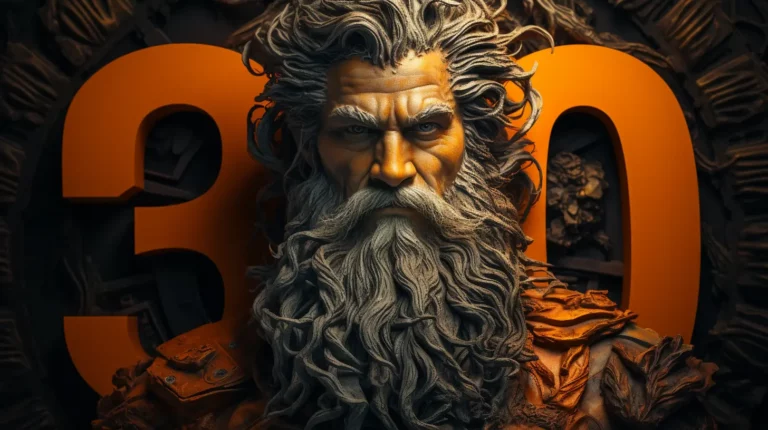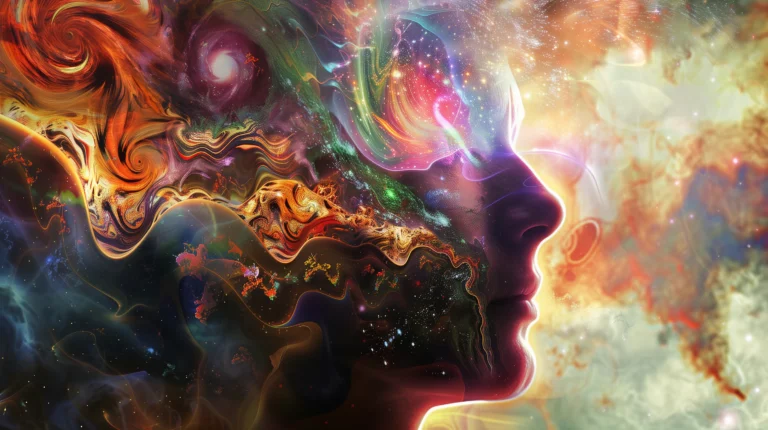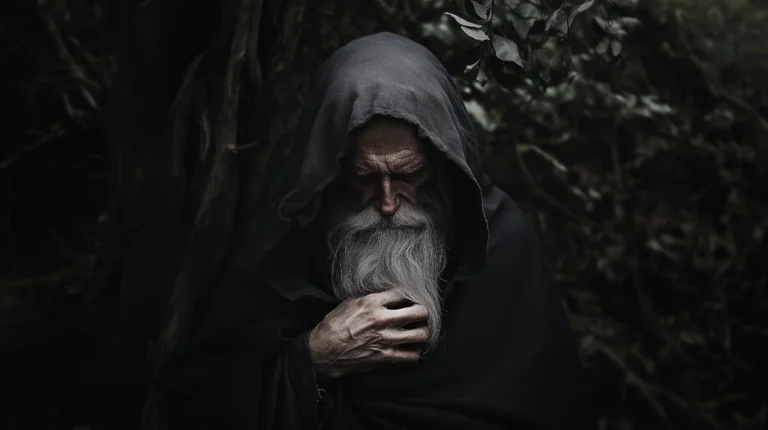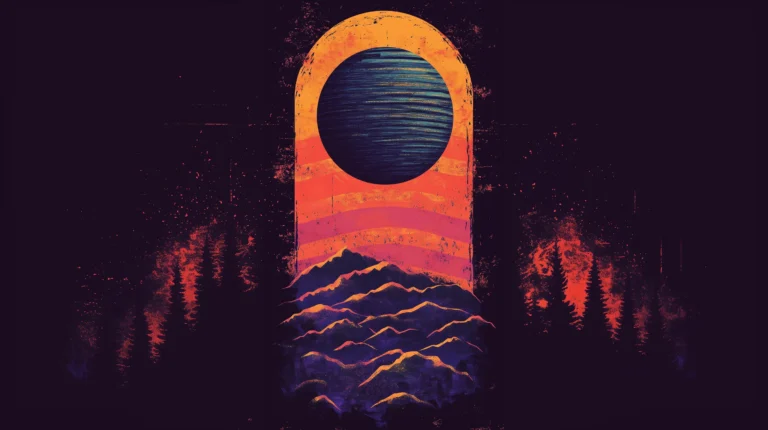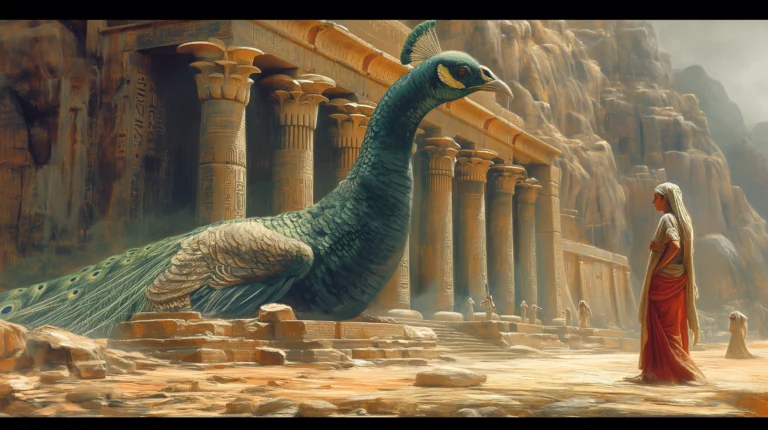Cosmic Threads: An Intermediate’s Guide to Theosophical Mysteries
Table of Contents:
Chapter 1: The Tapestry of the Universe
- Understanding the Fundamental Propositions
- The Law of Cycles: The Eternal Dance
Chapter 2: Before the Beginning
- The Unmanifested Cosmos: The Silence Before the Dawn
- The Night of the Universe: A Timeless Slumber
Chapter 3: The Awakening Cosmos
- Stirrings in the Dark: The First Logos
- The Luminous Lotus: The Birth of Potential
Chapter 4: The Weaving of the World
- The Divine Blueprint: From Darkness to Light
- The Play of Elements: Fire, Water, and the Spirit-Matter
Chapter 5: The Dance of Creation
- The Cosmic Ballet: Expansion and Contraction
- The Emanation of Life: The Role of Fohat
Chapter 6: The Veil of Maya
- Understanding Illusion in the Theosophical Cosmos
- The Eternal Play: Manifestation and Beyond
Chapter 7: The Great Builders
- Architects of the Universe: The Dhyan Chohans
- The Ladder of Life: From Atoms to Galaxies
Chapter 8: The Cycle of Becoming
- The Rhythm of Existence: From Birth to Rebirth
- Karma and Evolution: The Journey of the Soul
Chapter 9: The Fabric of Reality
- The Sevenfold Nature of Consciousness
- The Web of Being: Matter, Energy, and Thought
Chapter 10: The Human Connection
- Our Place in the Cosmos: Microcosm and Macrocosm
- The Path to Enlightenment: Ethics and Wisdom
Chapter 11: The Closing Cycle
- Twilight of the Cosmos: Preparing for Pralaya
- Pralaya: The Cosmic Night and Rebirth
Chapter 12: Synthesis and Enlightenment
Preface
Welcome to a journey through the mysteries of the cosmos as seen through the lens of theosophy. This guide is crafted for young minds eager to explore the rich tapestry of universal laws and ideas that theosophy presents. It’s an invitation to ponder the profound, to question the commonplace, and to look beyond the visible towards the vast unseen.
Theosophy is an intriguing blend of philosophy, science, and spirituality, drawing from the wisdom of ancient traditions and modern inquiry. Its teachings offer a unique perspective on the interconnectedness of all life and the intricate workings of the universe. These ideas are not just for contemplation but for weaving a deeper understanding of our place in the grand scheme of things.
In this book, we present these concepts in language that is clear and accessible, breaking down complex ideas into digestible parts. We aim to illuminate the path for intermediate learners, providing clarity and insight into theosophical thought. Our mission is to make the profound teachings of theosophy as approachable and relatable as possible.
As we embark on this exploration, remember that theosophy is not just a set of teachings but a way of seeing the world. It’s a living philosophy that invites us to become active participants in our own spiritual evolution and the evolution of our world.
So, with an open heart and an inquisitive mind, let’s begin our exploration into the heart of theosophical wisdom.
Chapter 1:
The Tapestry of the Universe
Understanding the Fundamental Propositions
Imagine the universe as a vast, intricate tapestry. Each thread represents a different aspect of existence: stars, planets, people, and even thoughts are all threads in this cosmic fabric. Theosophy teaches us that nothing in this tapestry is isolated; every thread is connected, creating a complete and harmonious pattern. This is the essence of the first fundamental proposition of theosophy: unity.
Unity in theosophy means that everything, from the smallest particle to the largest galaxy, is interlinked. This interconnectedness is not merely physical but spiritual. It suggests that at the deepest level of reality, there is no separation—everything is part of a single, living whole. It’s like a spider’s web; if you touch one part, the whole web vibrates. In the same way, each action we take reverberates throughout the entire universe.
The second fundamental proposition introduces the concept of the Law of Cycles. Just as the Earth rotates on its axis and orbits the sun, bringing about day and night and the seasons, theosophy proposes that the universe itself goes through vast cycles of birth, life, death, and rebirth. These cycles are not just physical phenomena; they are also spiritual, affecting the evolution of our souls.
The cycle begins with a period of activity or manifestation, known as Manvantara, a time when the universe is in full bloom, teeming with life and action. Following this is a period of rest or Pralaya, when the universe is said to be in a state of dormancy, like a field lying fallow, gathering energy for the next cycle of growth. This rhythm of activity and rest is eternal; it has no beginning and no end.
The Law of Cycles also applies to us as individuals. We experience our own cycles of waking and sleeping, working and resting, living and dying. But theosophy teaches that our journey doesn’t end with death. Instead, death is simply a doorway to a different state of being, after which we return once again in a new form, continuing our cycle of growth and learning.
As you reflect on these fundamental propositions, consider how they might change your perspective on life. If everything is connected, how does that affect the way you interact with the world? If life is a cycle, what might that mean for your understanding of life’s challenges and changes?
The Law of Cycles: The Eternal Dance
The Law of Cycles is not just a grand cosmic principle; it is also an intimate part of our everyday experience. It teaches us that life is not a straight line but a circle or, more accurately, a spiral. Each cycle brings us back to where we started, but not quite; we return a little wiser, a little more evolved.
Think of a day: it begins with dawn, rises to the fullness of noon, dims into dusk, and then falls into the darkness of night, only to begin again. Our lives follow a similar pattern: birth leads to growth, growth leads to maturity, maturity leads to decline, and decline leads to death—and then rebirth.
The cyclical nature of existence is mirrored in the changing seasons, the lunar phases, and even the tides. It’s a dance that is both predictable and awe-inspiring. Just as dancers move to the rhythm of music, so too does the universe move to the rhythm of these cycles.
Theosophy gives these cycles a broader context. It suggests that our souls are on a long journey of evolution, experiencing many lives, learning many lessons. Each life is an opportunity to dance a new dance, to play a new role in the great performance of existence.
But why is this dance eternal? Theosophy offers a profound answer: the cycles are the universe’s way of providing endless opportunities for growth and realization. Every end is a new beginning, every night brings a new dawn, and every life offers a fresh start. This is the universe’s gift to us—the chance to evolve endlessly, to reach ever-greater heights of understanding and compassion.
As we close this section, think about the cycles in your own life. How can you see them not as monotonous repetitions but as chances for renewal and transformation? How can understanding the Law of Cycles change the way you view the world and your place in it?
With these reflections, we weave the first threads into our understanding of the tapestry of the universe, setting the stage for a deeper exploration of theosophical wisdom.
Chapter 2:
Before the Beginning
The Unmanifested Cosmos: The Silence Before the Dawn
Before the universe as we know it began to take shape, there was a vast expanse of silence—an unmanifested cosmos. This stage in theosophical understanding is like the deep quiet that fills the world in the moments before dawn. It’s a time of potential, where everything that could ever be lies waiting in stillness.
This unmanifested cosmos is not empty but full of latent energy. It’s like a blank canvas before the artist’s brush touches it or a story waiting to be told. This is the realm of pure possibility, where the laws of nature as we understand them are not yet in effect because nature itself has not yet been formed.
In this state, there is no movement, no change, no time, no space—only the presence of something infinite and eternal. It’s a concept that challenges our minds because it’s beyond our experience of reality, where everything is subject to change and bound by time.
Theosophy uses the term ‘pralaya’ to describe this condition—a period of cosmic rest. During pralaya, the universe is not destroyed but retracted into a state of latency, like a seed waiting for the right conditions to sprout. It’s a necessary pause, allowing the cosmos to rejuvenate and prepare for the next cycle of manifestation.
The Night of the Universe: A Timeless Slumber
The night of the universe is a concept that extends the idea of the unmanifested cosmos into a state of timeless slumber. It’s as if the universe has closed its eyes, and all the stars, planets, and life forms have dissolved back into the darkness from which they came. This is not a physical darkness but a metaphorical one, representing the absence of manifestation.
In this phase, the universe is unified. There is no distinction between one thing and another because nothing has yet differentiated. It’s a condition of oneness where the potential for all life, all matter, and all spirit is merged into a singular state of being.
This time of rest is not simply a cessation of activity but a critical phase in the life of the cosmos. It is during this period that the universe is said to reset itself. Just as sleep allows living beings to process the experiences of the day and rejuvenate, the cosmic night allows the universe to integrate the experiences of the past cycle and renew itself for the future.
In the silent darkness of the cosmic night, the foundations for the next cycle of creation are laid down. The energies that will give rise to new forms and new life are gathered and conserved. It’s a reminder that even in stillness, there is purpose and preparation for growth and evolution.
As we contemplate the night of the universe, we’re invited to consider the importance of rest and stillness in our own lives. Just as the cosmos takes time to pause and renew, so too must we find moments of quiet and reflection to nourish our own potential for growth and change.
This chapter sets the stage for understanding the immense cycles of the cosmos and our part in them. It’s a prelude to the awakening that follows, as the universe moves from silence and stillness into the symphony of creation.
Chapter 3:
The Awakening Cosmos
Stirrings in the Dark: The First Logos
As the silence of the unmanifested cosmos stretches infinitely, a subtle change begins to occur—a gentle vibration, the first pulse of consciousness, known as the First Logos. This is the dawning awareness within the cosmos, the initial point of light in the boundless dark. It is an abstract concept, representing the unified potential of all that will come to be.
The First Logos is not a being or entity; rather, it is the primal thought or the divine idea that precedes physical form. It is as if the universe itself has had its first thought, a concept so powerful and all-encompassing that it will become the blueprint for everything that follows. The First Logos holds within it the patterns that will shape galaxies, stars, planets, and the very fabric of reality.
The Luminous Lotus: The Birth of Potential
From the First Logos, the cosmos begins to take its first breath, and with it, the birth of potential unfolds. This potential is symbolized by the luminous lotus, an ancient emblem of emergence and enlightenment. The lotus represents the universe in its nascent stage, still folded within itself, containing the patterns of all future existence.
As the lotus begins to bloom, each petal reveals a new aspect of the cosmos coming into being. It is a slow and majestic unfolding, each movement deliberate and filled with purpose. This process is the cosmos awakening from its slumber, bringing forth the myriad possibilities contained within the First Logos.
The luminous lotus also represents the purity of the cosmos at this stage—untouched and pristine. It is the spiritual essence of the universe before it takes on the complexities of material form. In this state, the cosmos is still one, undivided, and harmonious, akin to the lotus floating above the muddy waters, untainted and serene.
The First Logos and the luminous lotus together signify the initial stages of the cosmos’s awakening—a universe on the cusp of creation, poised to embark on the grand journey of existence.
Chapter 4:
The Weaving of the World
The Divine Blueprint: From Darkness to Light
The transformation of the unmanifested cosmos begins with a divine blueprint, a preordained plan that emerges from the depths of darkness into light. This blueprint is the First Logos in action, the intelligent design that underlies the structure of the universe. It’s akin to an architect’s vision before the foundation of a building is laid, containing all the measurements, shapes, and connections required for the structure, yet it remains unseen and intangible.
In this stage of cosmic evolution, the abstract thought of the First Logos materializes into the initial patterns of the universe. The darkness, once a silent and formless void, begins to pulse with the potential for life and matter. It’s a transition from nothingness into somethingness, from emptiness into fullness. This is the point at which the latent energy held within the darkness starts to coalesce, guided by the First Logos, into the first forms of existence.
The movement from darkness to light is gradual and profound. It represents enlightenment, understanding, and the revelation of the hidden. Just as dawn breaks the night, bringing clarity and color to the world, the divine blueprint illuminates the cosmos, allowing the intricate details of life and existence to unfold.
The Play of Elements: Fire, Water, and the Spirit-Matter
As the blueprint unfolds, the elements begin their dance. Fire, water, and spirit-matter are the primary actors in this cosmic play. Fire represents transformation, energy, and the spark of creation. It is the force that warms the cold, inert matter of the cosmos, igniting the processes that will lead to life. Water symbolizes fluidity, intuition, and the flow of potential into form. It is the nurturing element that allows the nascent forms within the cosmic blueprint to grow and develop.
Spirit-matter is the canvas upon which fire and water dance. It is the substance of the cosmos, both tangible and ethereal. In theosophy, spirit and matter are not separate entities but two aspects of the same fundamental essence. The spirit is the life force, the consciousness that animates matter, while matter is the physical form that spirit takes on.
Together, these elements weave the world into being. Fire activates, water shapes, and spirit-matter forms the basis of all that is seen and unseen. They work in harmony, each contributing to the creation of the cosmos according to the divine blueprint. The interplay of these elements results in the diverse and dynamic universe we observe, a tapestry of existence that is ever-changing and yet eternally the same.
Chapter 5:
The Dance of Creation
The Cosmic Ballet: Expansion and Contraction
In the heart of the cosmos, a rhythmical dance unfolds—the dance of expansion and contraction, a cosmic ballet that orchestrates the flow of life and energy throughout the universe. This pulsation is akin to the breathing of the cosmos, an ebb and flow that maintains the balance and harmony of creation.
The expansion phase is a period of outward movement, a time when the universe extends its boundaries, creating space for stars, galaxies, and planets to form and evolve. It is during this phase that the cosmos spreads out, exploring the potentials and possibilities held within the divine blueprint. Expansion is a phase of exploration, growth, and expression, where the universe expresses its creativity and dynamism.
Conversely, the contraction phase is a period of inward movement, a return to the core. It is a time of introspection and integration for the cosmos. During contraction, the universe pulls back, condensing its energies and experiences. This phase allows the cosmos to assimilate and internalize the lessons and growth from the expansion phase. Contraction is as vital as expansion, providing a period of rest, reflection, and renewal.
Together, these phases of expansion and contraction form the cosmic ballet, a graceful and continuous flow that shapes the rhythm of existence. This pulsation is not just a physical phenomenon; it reflects the deeper spiritual and metaphysical cycles that govern the evolution of consciousness and being.
The Emanation of Life: The Role of Fohat
As the cosmic ballet unfolds, a dynamic force comes into play, vital for the emanation of life and the orchestration of the elements—Fohat. In theosophy, Fohat is the cosmic energy that animates and links the spirit and matter, the bridge between thought and reality, the divine and the material.
Fohat is often described as the divine messenger, the agent of creation that translates the divine blueprint into physical reality. It is the electric life force that courses through the cosmos, igniting the fires of stars, stirring the waters of oceans, and breathing life into all forms of existence.
In the dance of creation, Fohat plays a crucial role. It is the force that propels the expansion of the universe, the spark that initiates the birth of galaxies and worlds. During the phase of contraction, Fohat works to weave together the experiences and energies of the cosmos, creating a tapestry of consciousness that enriches the universe.
The role of Fohat in the emanation of life is both transformative and integrative. It transforms the abstract ideas of the divine mind into tangible realities and integrates these realities into the grand scheme of the cosmos. Fohat is the conductor of the cosmic orchestra, ensuring that each element of creation plays its part in the grand symphony of existence.
Chapter 6:
The Veil of Maya
Understanding Illusion in the Theosophical Cosmos
In theosophy, the concept of Maya is central to understanding the nature of our universe. Maya, often translated as “illusion,” refers to the way we perceive the world around us. It suggests that our sensory experiences and our understanding of reality are not the complete truth but a limited and sometimes misleading representation of a much vaster, more intricate cosmic reality.
Maya is like a veil that covers our eyes, preventing us from seeing the full spectrum of existence. It’s akin to watching a play on stage and believing that the characters and their stories are real. Just as the audience gets caught up in the drama, forgetting that it’s a production with actors and scripts, we too get absorbed in the material world, often overlooking its deeper spiritual essence.
Theosophy teaches that while the physical world is real, it’s not the ultimate reality. It’s a temporary, ever-changing aspect of a larger, more permanent cosmic truth. The material world is subject to decay, change, and dissolution, but behind it lies something eternal and unchanging. This deeper reality is hidden by the veil of Maya, and it’s only by looking beyond the veil that we can glimpse the true nature of existence.
The Eternal Play: Manifestation and Beyond
The concept of Maya leads us to the idea of the universe as an eternal play, a continuous cycle of manifestation and dissolution. In this play, the cosmos is constantly creating and recreating itself, with each cycle bringing forth new forms, experiences, and possibilities.
In the theosophical view, the process of creation is not just a one-time event but an ongoing act. The universe is like a canvas on which the divine consciousness paints an ever-evolving picture. This picture is made up of galaxies, stars, planets, and life forms, all participating in the grand drama of existence.
However, this drama is not just a random series of events. It’s guided by a purpose, a divine plan that drives the evolution of the cosmos toward greater complexity and consciousness. This plan unfolds through the Law of Cycles, ensuring that nothing is ever truly lost or forgotten. Instead, every experience, every life, every star is part of a continuous thread that weaves through the fabric of time and space.
The play of the universe is also a play of consciousness. As spiritual beings, we are not just passive observers but active participants in this cosmic drama. Our journey through life, through the cycles of birth, death, and rebirth, is an opportunity to learn, grow, and evolve. By understanding the illusion of Maya and recognizing the deeper spiritual reality, we can play our roles with greater awareness and purpose, moving beyond the material aspects of existence to embrace our true nature as eternal, spiritual beings.
Chapter 7:
The Great Builders
Architects of the Universe: The Dhyan Chohans
In theosophy, the architects of the universe are known as the Dhyan Chohans (Archangels), a term that refers to the high spiritual beings responsible for the creation and maintenance of the cosmos. These beings are not gods in the traditional sense but are more like master builders or cosmic engineers, overseeing the intricate processes that shape the physical and spiritual realms.
The Dhyan Chohans (Archangels) work in accordance with the divine blueprint, the plan set forth by the First Logos. They are the agents of creation, translating the abstract ideas of the divine mind into the tangible realities of the universe. Their role is to manifest the potentialities held within the cosmic consciousness, ensuring that the universe evolves according to its intended design.
Each Dhyan Chohan has a specific function and domain, overseeing different aspects of cosmic creation. Some are responsible for the formation of galaxies, others for the birth of stars and planets, and still others for the evolution of life and consciousness. They work in harmony, guided by the laws of theosophy, such as karma and dharma, ensuring that the cosmic order is maintained.
The concept of the Dhyan Chohans highlights the idea that the universe is not a random or chaotic assembly but a purposeful and orderly creation. It’s a reminder that behind the physical appearance of the cosmos lies a deeper, spiritual structure, governed by intelligence and wisdom.
The Ladder of Life: From Atoms to Galaxies
The ladder of life in theosophical cosmology represents the hierarchy of existence, from the smallest atom to the vastest galaxy. It’s a metaphor for the evolutionary journey that all forms of life, matter, and consciousness undergo in their path towards spiritual perfection.
At the bottom of the ladder are the atoms, the basic building blocks of the physical universe. Even at this fundamental level, there is consciousness, albeit in a latent or dormant form. As we ascend the ladder, we encounter increasingly complex and conscious forms of existence.
Plants, animals, and humans each occupy their rungs on the ladder, representing different stages of consciousness and spiritual development. Humans, with their capacity for self-awareness and reasoning, hold a unique position, serving as a bridge between the material and spiritual worlds.
Beyond the human realm, the ladder extends into the celestial or spiritual realms, where beings like the Dhyan Chohans (Archangels) reside. These higher beings represent advanced stages of spiritual evolution, having transcended the limitations of physical form and mundane consciousness.
The ladder of life is not just a hierarchy but a pathway of progression. It illustrates the potential for growth and evolution that lies within all forms of existence. The journey up the ladder is one of expanding consciousness, increasing complexity, and deepening understanding, leading ultimately to a reunion with the divine source from which all life originated.
Chapter 8:
The Cycle of Becoming
The Rhythm of Existence: From Birth to Rebirth
In theosophy, the cycle of becoming is an endless rhythm of birth, life, death, and rebirth. This cycle is not just a physical process but a spiritual one, reflecting the journey of the soul as it evolves through various experiences and forms.
At birth, a new cycle begins. The soul, carrying with it the wisdom and experiences from previous lives, enters a new physical form. This entry into the world is not random; it is guided by the law of karma, which determines the conditions and circumstances of the birth based on past actions and lessons.
Life is the stage where the soul engages with the world, learning, growing, and experiencing. It’s a time for the soul to express itself, to interact with others, and to face challenges and opportunities that contribute to its evolution. Every experience, whether joyous or difficult, serves as a lesson and an opportunity for spiritual growth.
Death is not the end but a transition. It’s a moment when the soul sheds its physical form, like a butterfly emerging from a cocoon. Death is a release, freeing the soul from the limitations of the physical body and allowing it to return to a more subtle, spiritual state.
Rebirth is the soul’s return to the physical world, beginning a new cycle of learning and growth. It’s a continuation of the soul’s journey, an opportunity to apply the wisdom gained in previous lives and to undertake new experiences that will further its evolution.
The cycle of becoming is a profound and eternal rhythm, a dance of the soul through time and space, constantly moving towards greater understanding, compassion, and enlightenment.
Karma and Evolution: The Journey of the Soul
Karma plays a central role in the cycle of becoming. It is the law of cause and effect, ensuring that every action has a corresponding reaction. Karma is not a system of punishment or reward but a natural law that guides the soul’s evolution.
Each action, thought, and intention generates karma, which influences the soul’s journey. Positive actions lead to beneficial effects, creating conditions that support the soul’s growth and happiness. Negative actions, on the other hand, result in challenges and difficulties, providing opportunities for the soul to learn important lessons and to redress imbalances.
Evolution, in the theosophical sense, is not just a physical process but a spiritual one. It’s the gradual development of the soul as it gains wisdom, expands its consciousness, and moves closer to its divine nature. This evolution is not linear but cyclical, with each life providing unique experiences and lessons.
The journey of the soul is a long and winding path, filled with joys, sorrows, triumphs, and challenges. It’s a journey of self-discovery, where the soul learns about itself, the universe, and its place within it. Through the process of karma and evolution, the soul gradually sheds its limitations, overcomes its ignorance, and realizes its true nature as a divine, eternal being.
This journey is not just a personal one; it’s connected to the evolution of all beings and the universe itself. As each soul evolves, it contributes to the collective growth and upliftment of all existence, moving towards a future of harmony, understanding, and unity.
Chapter 9:
The Fabric of Reality
The Sevenfold Nature of Consciousness
In theosophy, consciousness is not a singular, uniform entity but a complex, multi-layered phenomenon. This concept is encapsulated in the idea of the sevenfold nature of consciousness, which posits that our awareness operates on multiple levels, each with its distinct characteristics and functions.
- Physical Consciousness: This is the most immediate form of consciousness, linked to our physical senses and body. It’s our awareness of the tangible world, our ability to interact with and perceive our physical environment.
- Etheric Consciousness: Closely tied to the physical, the etheric level relates to the vital energies and life forces that sustain our physical bodies. It’s a subtle form of awareness, often associated with the sensations of life force or ‘prana’.
- Emotional Consciousness: This level embodies our feelings and emotions. It’s more fluid and dynamic than the physical and etheric levels, strongly influencing our interactions with others and our subjective experiences of the world.
- Mental Consciousness: This aspect represents our thoughts, ideas, and rational processes. It’s where we analyze, conceptualize, and engage in abstract thinking.
- Spiritual Consciousness: Here, our awareness begins to transcend the individual self and connect with higher spiritual truths. It’s an understanding and experience of deeper universal connections and meanings.
- Intuitive Consciousness: At this level, consciousness taps into a form of direct knowing or insight that goes beyond rational thought. It’s a more holistic understanding that integrates deeper wisdom.
- Divine Consciousness: The highest level of consciousness, where individual awareness merges with the universal consciousness. It represents enlightenment, a state of unity with all that is.
These seven levels interweave to form the complete tapestry of human consciousness, each contributing to our experience and understanding of reality.
The Web of Being: Matter, Energy, and Thought
Theosophy views reality as an intricate web composed of matter, energy, and thought. These three elements are not separate entities but interconnected aspects of the same fundamental substance.
- Matter: In theosophy, matter is more than just physical substance; it’s a form of condensed energy. It’s the manifestation of energy in a form that we can perceive and interact with in the physical world.
- Energy: Energy is the force that animates matter, giving it motion and activity. It’s the dynamic aspect of reality, constantly in flux, transforming and moving in endless cycles and patterns.
- Thought: Thought, or consciousness, is the organizing principle that shapes matter and energy. It’s the creative force that molds the fabric of reality, turning potential into actuality.
These three elements are in a constant state of interaction and transformation, each influencing and being influenced by the others. Matter provides the form, energy the motion, and thought the direction and purpose.
The web of being is a holistic concept that encapsulates the interconnectedness and interdependence of all things. It suggests that everything in the universe, from the smallest atom to the largest galaxy, is part of a single, unified whole. This interconnectedness implies that our thoughts and actions have far-reaching effects, extending beyond our immediate environment and influencing the broader fabric of reality.
Chapter 10:
The Human Connection
Our Place in the Cosmos: Microcosm and Macrocosm
In theosophical thought, the relationship between the human being and the cosmos is described through the concepts of microcosm and macrocosm. This perspective posits that each individual (microcosm) is a reflection of the universe (macrocosm) in miniature.
The human being is seen as a condensed version of the universe, embodying the same fundamental principles and laws that govern the cosmos. Just as the universe is composed of various elements and energies, so too is the human body and spirit. This concept extends beyond the physical body to include mental, emotional, and spiritual dimensions. Every aspect of human existence mirrors some aspect of the cosmic whole.
This relationship implies a deep connection between the individual and the cosmos. It suggests that by understanding ourselves, we can gain insights into the universe, and conversely, by studying the universe, we can learn about our true nature. This concept emphasizes the unity and interconnectedness of all existence and encourages a holistic view of life, where physical, mental, and spiritual aspects are all interrelated and significant.
The Path to Enlightenment: Ethics and Wisdom
In theosophy, the journey toward enlightenment is both an inward and outward pursuit, involving ethical living and the acquisition of wisdom. This path is not solely about personal salvation or liberation but is also about contributing to the greater good and evolution of all beings.
Ethical living, in the theosophical sense, involves more than just adherence to moral codes or societal norms. It is about developing a deep sense of compassion, empathy, and responsibility for others and for the world. It means living in a way that reflects the inherent unity and interconnectedness of all life, recognizing that our thoughts, actions, and decisions have consequences that extend beyond our immediate selves.
Wisdom, on the other hand, is the deep understanding and insight into the nature of reality. It’s not just intellectual knowledge but also includes intuitive understanding and spiritual awareness. Wisdom involves seeing beyond the illusions and transient aspects of the world (Maya) and understanding the deeper truths that underlie existence.
The path to enlightenment is a journey of continuous learning, self-discovery, and transformation. It involves balancing the quest for personal spiritual growth with the commitment to the welfare of others. By walking this path, individuals contribute to the collective evolution of consciousness and help in bringing about a more harmonious and enlightened world.
Chapter 11:
The Closing Cycle
In theosophical teachings, the concept of the universe is cyclic, involving not only its beginning and flourishing but also its eventual winding down and closure, a phase known as the “Closing Cycle.” This phase is as crucial to the grand cosmic process as the creation and sustenance periods.
Twilight of the Cosmos: Preparing for Pralaya
As the cycle of active existence (Manvantara) nears its end, the universe enters a period akin to twilight, a gradual transition into a state of rest or Pralaya. During this time, the processes that have driven the expansion and evolution of the cosmos begin to slow down and converge towards a state of equilibrium.
This cosmic twilight is not a sudden cessation but a gentle, methodical return to the original state of undifferentiated oneness. It’s a time for the universe to assimilate all the experiences, growth, and developments of the active phase. Just as night follows day, this period of rest is a natural and necessary counterpart to the vibrancy of cosmic activity.
In this phase, all forms of existence, from the smallest particles to the largest galaxies, gradually dissolve back into the fundamental essence from which they emerged. This dissolution is not destruction but a reintegration, a return to the source.
Pralaya: The Cosmic Night and Rebirth
Pralaya, often referred to as the cosmic night, is a period of non-activity where the universe exists in a state of potential. It is during Pralaya that the universe is said to rest, rejuvenate, and prepare for the next cycle of manifestation.
This period of rest is crucial for the ongoing process of cosmic evolution. Just as sleep allows living beings to process experiences and rejuvenate, Pralaya allows the universe to integrate the learning and advancements from the previous cycle and lay the groundwork for the next.
Pralaya is not the end but a pause. It’s a time of renewal and preparation, a phase where the accumulated wisdom of the past cycle is conserved and used as the seed for the next cycle of creation. The cosmic night is thus a period of immense potential, holding within it the blueprints for future universes, new forms of life, and new possibilities for existence.
In theosophy, the Closing Cycle is a reminder of the impermanence of all manifest forms and the eternal nature of the cosmic process. It teaches that endings are just precursors to new beginnings, and that in the grand scheme of the universe, there is no ultimate end, only transformation and renewal. This perspective encourages a view of life and existence as part of a larger, ongoing journey of growth and evolution, one that transcends individual lifetimes and cosmic epochs.
Chapter 12:
Synthesis and Enlightenment
In the quiet before the cosmic dawn, in the undifferentiated expanse where spirit and substance were one, the seeds of the universe were sown. This primordial state, a condition of absolute perfection, was the canvas upon which the cosmos would be brought into being. As “Cosmic Threads: An Intermediate’s Guide to Theosophical Mysteries” draws to a close, we reflect on this origin—a realm devoid of form and distinction, referred to as ‘darkness’ for the absence of division within it.
Through our exploration, we have followed the unfolding of the universe, witnessing the divine sparks—monads—begin their evolutionary pilgrimage. We have seen the cosmos manifest as a necessity, a ‘son’ born of the immutable, absolute reality. This reality, existing beyond the grasp of our minds, is a constant interplay of manifestation and dissolution.
In the chapters of this book, from the awakening cosmos in ‘Stirrings in the Dark’ to the intricate ‘Weaving of the World’, we have traced the divine blueprint, observing the cosmos as it stretches out—boundless, full of life, with the latent potential of existence simmering within its depths. The universe, ever in a state of becoming, breathes through cycles of creation and retreat, revealing the dance of the cosmic ballet.
This dance is not merely a cosmic event; it mirrors the spiritual journey of each soul. As we have ventured through the ‘Veil of Maya’, we have understood that the fabric of reality is a weave of matter, energy, and thought—a sevenfold nature of consciousness. Our place in this grand design, as discussed in ‘The Human Connection’, is both as observers and participants, microcosm and macrocosm, intertwined with the cosmic play.
Our closing chapter invites us to integrate the wisdom of the Theosophical cosmos with the evolution of our own spirit. Just as the universe experiences the twilight of the gods, preparing for renewal, we too must embrace transformation—where our learned truths become the stepping stones for further spiritual ascension.
Theosophy and modern thought converge here, at the twilight of our study, challenging us to expand our understanding and to continue the pursuit of enlightenment. We are reminded that the journey does not end; it merely transitions into new phases of discovery and growth.
As you assimilate the teachings presented, may you view every experience as an opportunity to contribute to the cosmic tapestry, weaving your actions with the threads of compassion and wisdom. The knowledge imparted within these pages is a call to action—a beckoning towards a life lived in harmony with the cosmic order.
May the end of this book be the beginning of your renewed journey, an odyssey of the soul towards the highest peaks of understanding and the deepest wells of compassion. Let the tapestry of the universe be a guide to the interconnectedness of all existence, as you tread the path to enlightenment, where no religion is higher than truth.
In the spirit of universal brotherhood and the perennial search for wisdom, may we all continue to weave our distinct threads into the ever-expanding tapestry of the cosmos.

